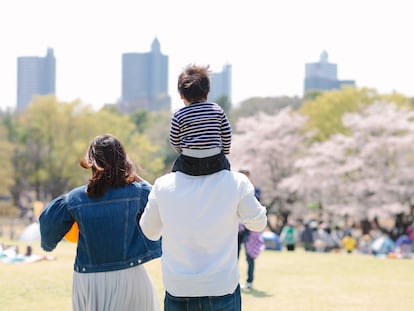Sara López, gynecologist: ‘Women who do not want to have children must be made visible’
The expert in assisted reproduction believes that women ‘accept an egg donation in a more rational way than men a sperm donation’

When Sara López specialized in assisted reproduction at the Hospital del Mar in Barcelona, Spain, she was not yet fully aware of the challenges she would be facing in her professional career. Over time, this specialist in obstetrics and gynecology who works at the Center for Infertility and Human Reproduction (CIRH), in Barcelona, understood that for many of her patients not achieving a pregnancy entailed physical and emotional exhaustion, and that many of them went through something called “genetic grief,” which occurs when a couple or a single mother is told that they will have to resort to foreign gametes. “Most patients don’t consider this scenario.” With this perspective in mind, she wrote Quiero quedarme embarazada: Claves para entender la reproducción asistida [I want to get pregnant: Keys to understanding assisted reproduction], a guide that explains the basic concepts that must be understood before embarking on the long path of assisted reproduction.
Question. In addition to being an emotional issue, is genetic grief a moral issue that has to do with a person’s values?
Answer. I wouldn’t say it’s necessarily moral. Thinking “this baby is not going to carry my genes, it’s not going to look like me at all,” is shocking for many people. I show them the chances of success with a change of gametes, and I explain that the genome varies very, very little from one person to another. That the idea of having a child is not to have a replica of oneself, but to take care of it, educate it, give it a life. The point is to make them reflect on what is important to them.
Q. Is it more difficult for men to accept a sperm donation than for women?
A. Historically, there’s the idea of masculinity linked to the alpha male, which is a social construct. I believe that the woman experiences everything more physically, in the first person, and because she has been experiencing all the phases in her own body, she accepts an egg donation in a more rational way. It is harder for the man.
Q. In your book, you explain that the causes of sterility are equally distributed: 30% of the time they are female, another 30% they are male. However, it is mostly women who undergo fertility treatments.
A. In the early 1980s, the age for a woman to have her first child was 25. Now we are almost at 33. This evolution, which comes from social, economic and work factors, punishes us, because while a 50-year-old man is still producing sperm, at that age she no longer has eggs or, if she does, they are of poor quality. The search for a natural pregnancy is more complicated for a 37 or 38-year-old woman.
Q. But the data suggests that, under equal conditions, with the same age, the causes of infertility are distributed equally between the sexes.
A. It is true that I’ve had couples of 30-year-old patients in whom the women are not the ones with the problem, but they’ve had to undergo in vitro fertilization because the seminogram was altered. When there are alterations in the seminogram, it’s the woman the one who has to undergo the treatment, no matter what. That is, the person who is not sick, so to speak, the one who doesn’t have the problem, is the one who has to do the treatment.
Q. Do we live in a society that makes women obsessed with fertility and pregnancies?
A. There’s a little bit of everything. There are women who want to be mothers, but if they haven’t achieved economic stability or found the right partner, they reach an age in which it becomes difficult. But then there’s the woman who doesn’t want to be a mother, and I think that’s the one that must be made more visible. There is a social pressure on them, the famous “you’re going to miss the boat.” Society should work on that, empathize and change.
Q. The book is aimed at heterosexual couples, female couples and single women. For which of the three models does assisted reproduction pose the greatest psychological challenge?
A. Heterosexual couples, definitely. Many come with the emotional baggage and the physical exhaustion of not conceiving at home, in the “romantic” way. The couple of girls or the single woman don’t come with the diagnosis of sterility; they haven’t been trying. I see the members of the heterosexual couple more affected, those to whom everyone keeps saying, “So when are you two going to start a family?”
Sign up for our weekly newsletter to get more English-language news coverage from EL PAÍS USA Edition
Tu suscripción se está usando en otro dispositivo
¿Quieres añadir otro usuario a tu suscripción?
Si continúas leyendo en este dispositivo, no se podrá leer en el otro.
FlechaTu suscripción se está usando en otro dispositivo y solo puedes acceder a EL PAÍS desde un dispositivo a la vez.
Si quieres compartir tu cuenta, cambia tu suscripción a la modalidad Premium, así podrás añadir otro usuario. Cada uno accederá con su propia cuenta de email, lo que os permitirá personalizar vuestra experiencia en EL PAÍS.
¿Tienes una suscripción de empresa? Accede aquí para contratar más cuentas.
En el caso de no saber quién está usando tu cuenta, te recomendamos cambiar tu contraseña aquí.
Si decides continuar compartiendo tu cuenta, este mensaje se mostrará en tu dispositivo y en el de la otra persona que está usando tu cuenta de forma indefinida, afectando a tu experiencia de lectura. Puedes consultar aquí los términos y condiciones de la suscripción digital.
More information
Últimas noticias
Most viewed
- Sinaloa Cartel war is taking its toll on Los Chapitos
- Reinhard Genzel, Nobel laureate in physics: ‘One-minute videos will never give you the truth’
- Oona Chaplin: ‘I told James Cameron that I was living in a treehouse and starting a permaculture project with a friend’
- Why the price of coffee has skyrocketed: from Brazilian plantations to specialty coffee houses
- David King, chemist: ‘There are scientists studying how to cool the planet; nobody should stop these experiments from happening’











































